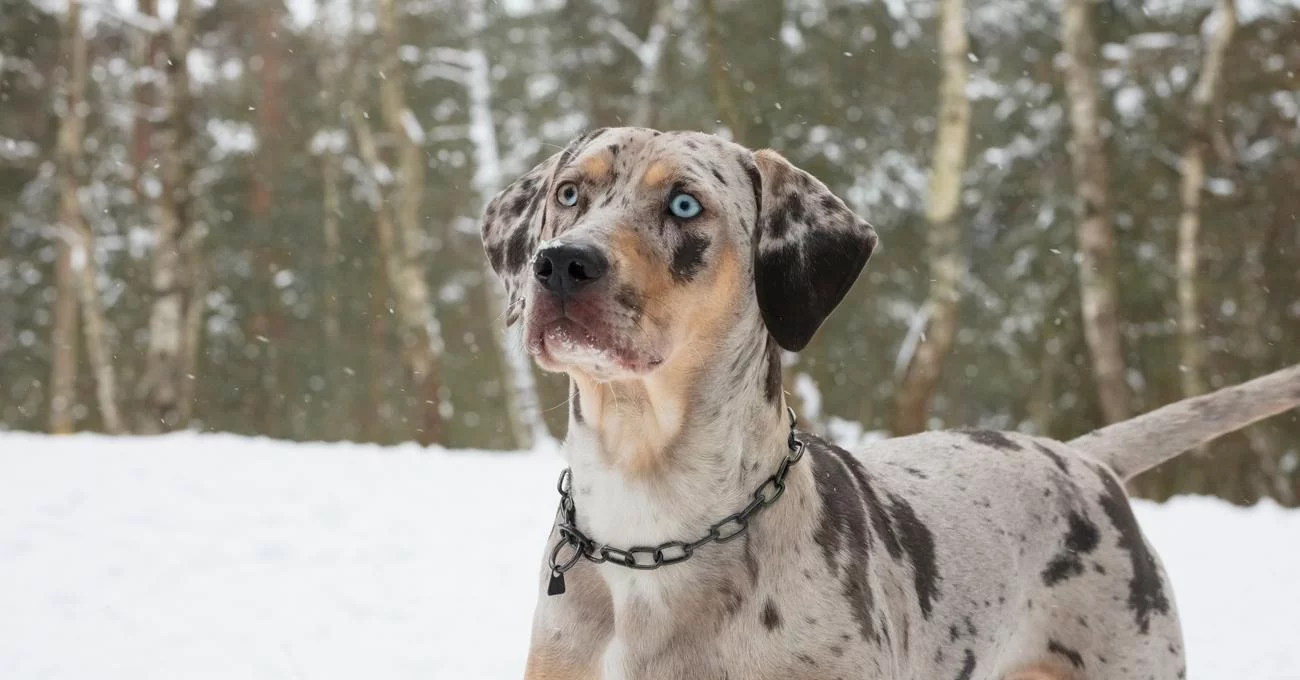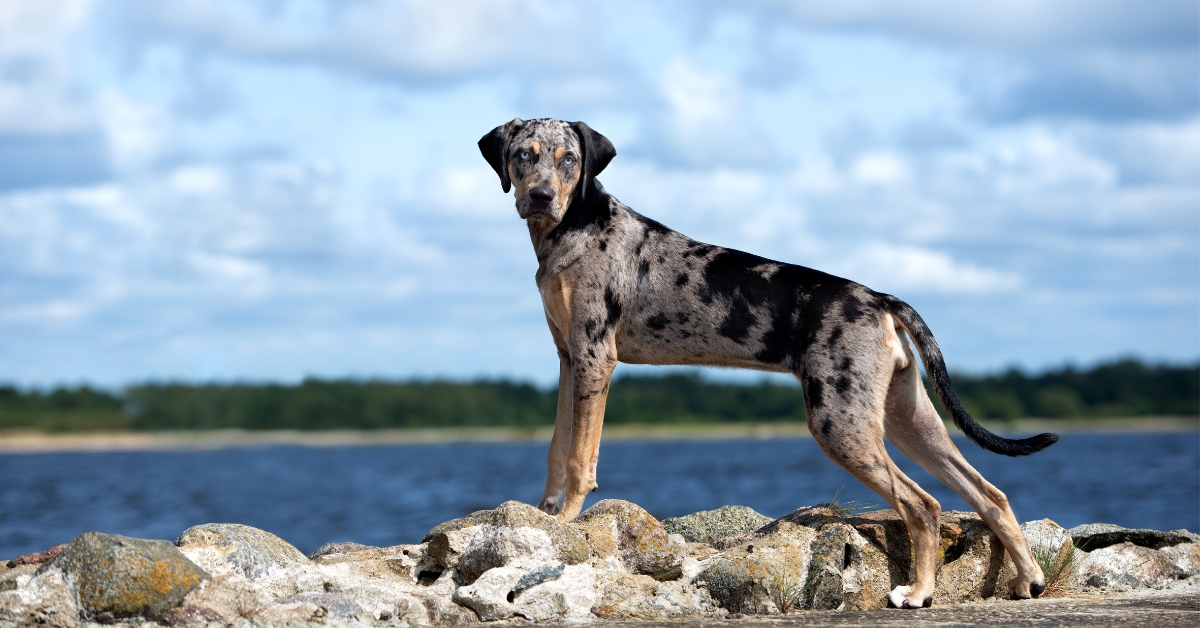Catahoula Blue Heeler Mix (A Complete Breed Guide)
Are you an active individual or family who loves unique, energetic breeds with a vibrant history? Then a Catahoula Blue Heeler Mix could suit you.

Key Takeaways
- The Catahoula Blue Heeler mix is a cross between the Catahoula Leopard Dog and Australian Cattle Dog.
- This mixed breed dog grows 17-24 inches tall and lives 10-15 years.
- This breed can be a great family dog if you have a yard for exercise and an active lifestyle.
Are you an active individual or family who loves unique, energetic breeds with a vibrant history? Then a Catahoula Blue Heeler Mix could suit you.
A Full Grown Catahoula Blue Heeler Mix is a crossbreed dog with a Catahoula Leopard parent and an Australian Cattle Dog parent. This dog breed grows 17-24 inches tall, weighs between 30-95 pounds, and lives for 10-15 years.
In this guide, we'll provide all the information you need to understand if this breed is the right fit for you. We’ll explain everything you need to know about the Catahoula Blue Heeler mix to be a responsible dog parent.
What is a Full Grown Catahoula Blue Heeler Mix? (A Comprehensive Guide)
The Catahoula Blue Heeler Mix is a designer dog breed resulting from the crossbreeding between a Catahoula Leopard Dog parent and a Blue Heeler (also known as the Australian Cattle Dog).
This hybrid dog is known for its high energy levels, work drive, and eye-catching coat patterns, which may include brindle, spots, and blotchy. As a mixed breed, this pooch combines the best traits of both parent breeds, making them fascinating and unique dog to explore.
Blue Heeler dogs are medium-sized and short-coated. Catahoula Leopard dogs are similarly sized and known for their muscular, powerful build. Overall, this is a fun and active dog to own and watch grow.
Catahoula Blue Heeler Mix Overview
Dog owners looking to adopt Catahoula Heeler puppies can refer to this table to learn critical details about this breed.
| Catahoula Blue Heeler Mix | Description |
|---|---|
| Size | Medium to large (depends on dominant parent traits) |
| Height | Approximately 17-24 inches |
| Lifespan | Roughly 10-15 years |
| Behavior | Intelligent, hardworking, energetic, potentially stubborn |
| Weight | Approximately 30-95 pounds (depending on dominant parent traits) |
| Coat Type | Short to medium length, dense |
| Coat Color | Varied, often merle or spotted; could be blue, black, brindle, or red |
| Exercise Needs | High; requires daily vigorous exercise and mental stimulation |
| Temperament | Loyal, protective, can be independent |
Catahoula Leopard Dog Breed History and Origin

Native Americans developed the Catahoula Leopard Dog by combining Native American dogs with breeds brought over by European explorers. The original Catahoula dogs had a mix of breeds, such as Greyhounds, Bloodhounds, and Mastiffs.
This versatile working dog is named after the Catahoula Parish in Louisiana, where it's believed to have originated. The Louisiana Catahoula Leopard Dog also became the state dog of Louisiana in 1979.
Blue Heeler (Australian Cattle Dog) Breed History and Origin

The Blue Heeler, or Australian Cattle Dog, has its roots in Australia and was developed in the 19th century as a herding dog for cattle. The breed is a mix of different dogs, including the Dingo, an Australian wild dog, and various European herding breeds.
This combination resulted in a highly skilled and intelligent working dog known for its high endurance levels, agility, and loyalty. Combining the herding and working abilities of both parent breeds, this hybrid dog is a versatile and impressive canine companion.
Catahoula Blue Heeler Mix Temperament and Personality
Training & Socialization Needs
The Catahoula Blue Heeler mix is a highly intelligent and energetic breed, making them eager learners. With early and consistent training, we can establish a strong bond with our dogs, helping them become well-behaved and friendly.
Socialization is crucial for this breed. By exposing them to various people, animals, and situations, we can help our Catahoula Blue Heelers feel more confident and comfortable in different environments.
Exercise and Activity Level Requirements
Catahoula Blue Heeler mixes have a high work drive and require a considerable amount of physical activity to stay happy and healthy. Engaging them in activities such as:
- Hiking
- Fetch
- Tug-of-war
These activities will not only keep our dogs fit but also mentally stimulated. It's essential to ensure they get at least 60 minutes of exercise daily to burn off their energy and prevent boredom that could lead to unwanted behaviors.
Interactive toys and puzzle games can also keep our dogs entertained and mentally challenged. By dedicating time to training, socialization, and exercise, we can provide our mixed breed dogs with a fulfilling and happy life.
Blue Heeler Catahoula Mix Grooming and Care
Coat Care and Maintenance
Catahoula Blue Heeler mixes have interesting coats with brindle, spots, and blotched patterns. In order to maintain their coat's health and appearance, we recommend brushing their fur at least once or twice a week.
This helps remove loose hair and improves air circulation against the skin to avoid mats and tangles. Catahoula Blue Heeler mixes are generally low-maintenance when it comes to grooming.
Their coats tend to be short and waterproof, making bath time less frequent. Bathing them once every couple of months or when noticeably dirty should suffice.
Nutrition, Feeding, & Diet
Feeding a Catahoula Blue Heeler mix requires considering their high energy levels and herding breed background. To support their muscle mass and fuel their activities, we recommend feeding these dogs a well-balanced diet of high-quality dog food.
Keep in mind their age, weight, and activity level when determining how much and how often to feed them. You should also provide fresh water for your dog at all times. Here's a general guideline for daily feeding:
- Puppies (3 to 6 months): 3 to 4 meals per day
- Older puppies (6 months to 1 year): 2 to 3 meals per day
- Adults (1 year and older): 1 to 2 meals per day
Health Factors & Conditions
Taking care of a this dog’s health involves monitoring for common health issues and attending to their exercise needs. Some health issues they might encounter include hip and elbow dysplasia.
Scheduling regular veterinarian check-ups and screenings can help detect and manage potential health problems. Since this breed is a mix of two high-energy herding dogs, they require plenty of exercise and mental stimulation.
Engaging them in activities like fetch, agility courses, or herding exercises keeps them physically active and mentally challenged. We recommend a minimum of 1 to 2 hours of daily exercise to ensure their happiness and well-being.
Blue Heeler Catahoula Mix Health & Nutrition
Lifespan
A Catahoula Blue Heeler dog is generally healthy with a lifespan of around 13-15 years. However, they can inherit certain health issues from their parent breeds.
To ensure a long and healthy life for this dog, it's important to stay aware of their health needs and to address any concerns promptly. These active dogs have a long life because of their Blue Heeler parent genes.
Diet & Exercise
The Catahoula Blue Heeler mix is an active and energetic dog that requires a nutritious diet and regular exercise. Since both parent breeds have high energy and work drive, it's essential to provide them with a diet rich in protein to fuel their active lifestyle.
A raw food diet or one with high-quality protein is the best for them and their overall health. When it comes to exercise, these dogs need regular physical activities to channel their energy and keep them mentally stimulated.
Activities such as walking, playing fetch, or participating in dog sports are great ways to keep this dog engaged and healthy.
Are Blue Heeler Catahoula Mixes Hypoallergenic?
This dog breed is not considered hypoallergenic. While no breed is completely hypoallergenic, some breeds are better suited for people with allergies because they produce fewer allergens.
Both the Catahoula Leopard Dog and the Blue Heeler are not listed among the hypoallergenic breeds, and they shed moderately. Therefore, a mix of these two breeds would not be the best choice for a family with allergies.
If allergies are a concern for your household, you might want to consider a breed known for being hypoallergenic, like a Poodle or Bichon Frise. Always spend time with a dog before bringing them into your home if you or a family member has allergies because individual responses to a specific dog can vary.
Since these mixes are not hypoallergenic, they may produce allergens that can affect those with pet allergies. To minimize this issue, we recommend:
- Regular grooming: Brush their coats at least once a week to reduce shedding and dander.
- Bathing: Bathe them every 4 to 6 weeks to keep their skin and coat clean.
- Clean living spaces: Vacuum and dust regularly to remove pet hair and dander from your home.
While all dogs produce some allergens, it's important to remember that individual reactions to these allergens can vary. Some people may experience mild symptoms while others might have more severe reactions.
Are Catahoula Blue Heeler Mixes Good Family Dogs?
Yes, the Catahoula heeler mix can be good family dogs, provided that we are willing to accommodate their exercise requirements and dedicate time to their training. With consistent care and attention, these unique dogs can become loyal and loving parts of any family.
First of all, we need to acknowledge that both parent breeds were developed for working purposes, which means these dogs tend to have a high work drive. They're ideally suited for an active, outdoorsy family with lots of space.
This can influence their energy levels and intelligence, so it's something to keep in mind as we consider their suitability for a family. Catahoula Blue Heeler mixes might be a great fit for active families who can provide sufficient exercise and mental stimulation.
Since they come from working breeds, they're likely to enjoy participating in activities or sports that challenge them physically and mentally. Their favorite activities might include hiking, running, or agility training.
While they may never be complete couch potatoes, they can learn to become well-behaved companions in various family settings with the right guidance. Just remember that meeting their physical and mental needs is essential to keep them happy and well-adjusted.
Ready to Transform Your Dog’s Behavior?

Mark Brunson